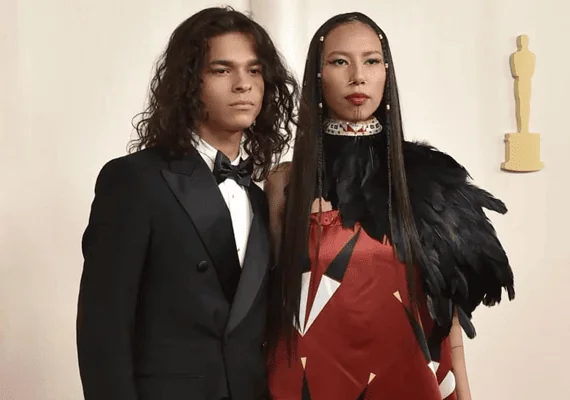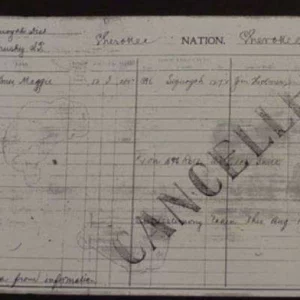Hollywood—When Norma Baker-Flyinghorse originally designed Quannah Chasinghorse’s red dress she wore on the red carpet for this year’s Oscars, it was for a separate function a year ago. What she wasn’t expecting was for her design to be single-handedly chosen as one of the favorite looks on the red carpet at this year’s Oscars by Anna Wintour, who has served as Editor-in-Chief of Vogue Magazine since 1988.
Vogue Magazine’s Chioma Nnadi and Chloe Malle, both longtime Vogue writers and editors, shared the first email they received from Anna Wintour was of Quannah Chasinghorse’s look on the red carpet. “The first email of the night was of Quannah,” said Vogue writer Chloe Malle on the brand’s podcast. “She loved Quannah.”
View this post on Instagram
Host Nandi and Malle played a soundbite of Wintour: “I loved Quannah Chasinghorse’s look,” she said on Vogue Magazine’s TikTok last week.
“It feels a bit overwhelming right now because it's always been important to me to properly represent my people,” said Norma Baker-Flyinghorse in an interview with Powwows.com when asked about her response to hearing of Vogue’s selection of this year’s best at the Oscar’s. “Everything I create has a story behind it and a purpose, and I never want to create anything to disrespect my people so knowing that I created something that got us into a space that we never imagine we would be, can only be described by me as amazing.”
Norma Baker-Flyinghorse is the founder and owner of Red Berry Woman, an award-winning Indigenous fashion couture brand that celebrates her Indigenous designs. Baker-Flyinghorse is Hidatsa from the Fort Berthold Indian Reservation and Dakota Sioux from the Fort Peck Indian Reservation in Montana and she strives to honor her heritage through her creations. Her designs have been showcased several times on various red carpets domestically and abroad, and she was previously chosen as Phoenix Fashion Week’s 2022 Designer of the Year.
An Indigenous brand being recognized by the fashion industry’s most recognized voices is a first though, and there are plenty of soundbites to go with it. In several interviews, Chasinghorse, with her partner D’Pharoah Woon-A-Tai, describes her gown and what it represents.
Quannah’s gown is a satin silk feather print representing her Lakota heritage, from her father’s side, adorned with a feather choker piece representing her Hän Gwich’in heritage, where she is Raven clan from her mother’s people. There is also a hand beaded choker that’s attached to her feather adornment and features Dakota designs made by Baker-Flyinghorse. She also wore a “cease fire” red pin, a popular item at the 96th Oscars.
Baker-Flyinghorse said it cost $120 to make Quannah Chasinghorse’s dress. “It’s on a list with dresses that costs thousands and thousands of dollars and, yet, these gallons of materials used to make the dresses end up going into storage or landfills eventually,” she said. “Quannah’s will always be cherished because that’s what we do as Indigenous people. We value our representation, and we value the items that do that for us. It’s not a trend. It’s not a fad. It’s who we are and we don’t need to spend $1 million to show everyone that on a red carpet.”
Red Berry Woman joins many a-listed luxury brands as a “favorite” from this year’s 96th Annual Academy Awards at Dolby Theatre at Hollywood & Highland Center in Hollywood such as Gucci, Louis Vuitton, Givenchy, Balmain, Dior, and many others. Lily Gladstone’s dress was a collaboration between Gucci and Joe Big Mountain, a well known flat-stitch porcupine quill artist of the Mohawk, Cree & Comanche Nations.
“I never imagined that the event would be the Oscars, nor did I ever imagine it would during such a historical event with Indigenous people rising,” said Baker-Flyinghorse. “Watching these young people rise to the top, and being a part of their journey has been absolutely honoring and amazing.”
“Killers of the Flower Moon”—nominated for 10 Oscars—brought a contingency of Indigenous people and representation to the 96th Oscars including a performance by Scott George, an Osage tribal citizen and nominee for Best Original Song. Lily Gladstone was a historic nominee as the first North American Indigenous person to compete for Best Actress (she lost to Emma Stone).
Feature Image – Red Berry Woman Facebook
Countdown to Gathering Giveaway
Bonus Code – 733309




